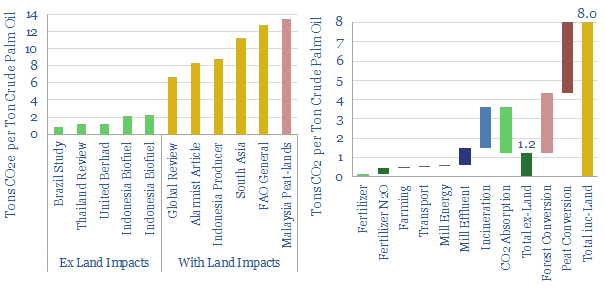Global palm oil production is running at 80MTpa in 2022, for use in food products, HPC products and bio-fuels. CO2 intensity of palm oil is assessed in this short note and data-file.
Palm oil is controversial, as it is linked to destruction of virgin rainforests. c40% of recent production has been associated with deforestation and c20% has been associated with peatland degradation.
The purpose of this data-file is to estimate the CO2 intensity of palm oil production, in tons of CO2e per ton of crude palm oil. We have aggregated data from 12 technical papers, and also constructed our own bottom up estimates.
Excluding land use impacts, we think palm oil production most likely has a CO2 intensity of 1.2 tons per ton, which is also an OK baseline estimate for responsible palm oil producers.
On a global average basis, including land use changes, we think CO2 intensity is around 8 tons per ton, assuming 40% of the land was deforested and 20% peat-degraded. The worst case scenario is a CO2 intensity of 20 tons/ton.
All of this matters for biofuels. Biodiesel sourced from the world’s average palm oil (8 tons/ton) is going to have 2.5x more emissions than burning conventional diesel. Likewise, if renewable diesel is produced from 65% used cooking oil, 35% palm oil, then again, it will have a higher CO2 impact than conventional diesel (model here).
To read more, please see our article here. Our main conclusion is that bio- and renewable diesel expansion plans may be stymied by tighter feedstock constraints and regulations (note here).

